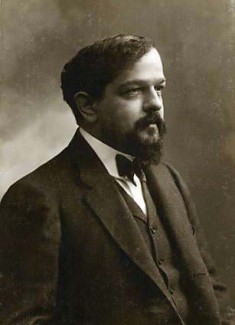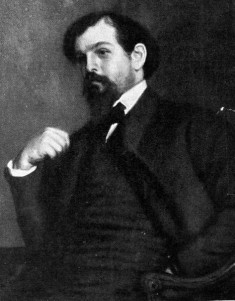| Claude Debussy | |
|---|---|
 |
|
| Composer | |
| Specialty | Impressionist music |
| Born | Aug. 22, 1862 |
| Died | Mar. 25, 1918 |
| Nationality | French |
Claude Debussy was a popular French composer who, together with Maurice Ravel, was amongst the most prominent figures in Impressionist music. He was also among the most influential composers of later 19th century and early 20th century.
Early Life
Claude Debussy was born on August 22, 1862 in France. He was the eldest of five children. His father, Manule Debussy, owned a shop where he sold crockery and China while his mom was a seamstress. In 1867, the family moved to Paris and a few years later, his mom sought refuge from Franco-Prussian war with Claude’s aunt in Cannes. At age seven, Claude started taking piano lessons which were paid for by his aunt.
At the early age of 10, Claude’s talents soon became evident and he entered the Paris Conservatoire where he spent his next 11 years. During his time in Paris, he studied composition, music theory and history, harmony, piano and organ.
Debussy as Musical Composer
In the year 1880, Nadezhda von Meck, who was a wealthy patroness, hired Claude to tech piano to her kids as they traveled through Russia and Europe. Together with Nadezhda and her kids, they began accumulating musical and many cultural experiences while in Russia. Debussy soon turned towards his compositions, gaining exposure from some Russian composers who greatly influenced his work.
When Debussy turned 22 in 1884, he entered his cantata entitled The Prodigal Son in the Prix de Rome. This was a competition for many different composers and Debussy took home the top prize. This prize allowed him to study for two years in the Italian capital of Rome. While Rome, he studied Richard Wagner’s music and especially his composition entitled Tristan und Isolde.
In 1887, Debussy went back to Paris and attended the Paris World Exhibition. Here, he heard the Javanese gamelan; this is a musical ensemble that is composed of numerous bells, xylophones, and gongs. It is at times accompanied by some vocals. In the years that followed, Claude incorporated the elements of gamelan into his style to create a totally new sound.
Popular Works and Compositions
During the late 1800s, Claude wrote some of his early masterpieces which include Ariettes oubliees in 1888 and String Quartet in 1893. In 1895, he completed his seminal opera entitled Pelleas et melisande. This was first performed in 1902 and it divided listeners with the audience either loving or hating it.
The success of Debussy’s Prelude in 1892 along with Pelleas earned Claude Debussy great recognition. Over the next 10 years, he was a leading figure in the French music scene. Other works that he wrote include La Mer in 1905, Iberia in 1908, Images in 1905 and Children’s Corner Suite in 1908.
Debussy’s Personal Life
Claude’s personal life was in most cases turbulent. At 18 years of age, he started an eight-year long affair with Marie Vasnier, who was married to a Parisian civil servant at the time. This relationship ended in 1884 after Claude moved to Rome. Later when he returned to Paris, Claude started another relationship with Gabriella Dupont, who was a tailor’s daughter.
In 1899, Debussey married a fashion model named Rosalie Texier. Five years later, Texier attempted suicide, but she survived. In 1905, he officially divorced Texier. In 1908, Claude married Emma Bardac and the couple had a child together. She was a great musical inspiration to him during their relationship.
Final Years and Death
 In 1903, he was made Chevalier of Legion of Honor in France. During his lifetime, he used non-traditional scales and chromaticism which influenced numerous composers who followed him in later years. Claude’s music is in most cases noted for its sensory component and frequent eschewing of tonality.
In 1903, he was made Chevalier of Legion of Honor in France. During his lifetime, he used non-traditional scales and chromaticism which influenced numerous composers who followed him in later years. Claude’s music is in most cases noted for its sensory component and frequent eschewing of tonality.
In 1909, Claude was diagnosed with cancer after he had some experiences with blood hemorrhaging. In December of 1915, he underwent a colostomy operation. On March 25, 1918, Claude Debussy died of rectal cancer while at his Paris home. His death occurred during WWI.
As the funeral procession made its way through the deserted streets to the cemetery, the sound of German guns bombarded the area. Since the military situation in France was very critical, Claude could not be honored with a public funeral. His body was reinterred after one year in a small Passy Cemetery. His wife and child are also buried next to him. His work still continues to inspire the musical creation many years later.